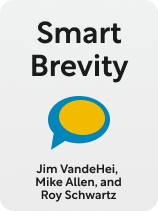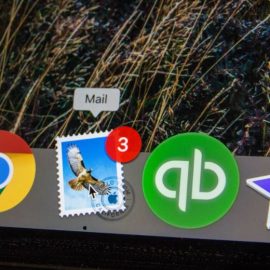

This article is an excerpt from the Shortform book guide to "Smart Brevity" by Jim VandeHei, Mike Allen, and Roy Schwartz. Shortform has the world's best summaries and analyses of books you should be reading.
Like this article? Sign up for a free trial here.
Are you able to capture your readers’ attention in today’s fast-paced digital world? How would things change if you could get your message across in fewer words?
In Smart Brevity, authors Jim VandeHei, Mike Allen, and Roy Schwartz offer valuable insights on crafting clear, impactful messages. They provide practical tips on how to write concisely, engage your audience from the start, and respect their time.
Read on to discover the key components of a well-structured message and why brevity matters in modern communication.
How to Write Concisely
If the question is how to grab readers in today’s crowded information marketplace, the answer is to be brief, but well-reasoned, constructing your message in a way that saves your readers’ time and respects their intelligence. VandeHei, Allen, and Schwartz outline four components of a well-structured message: a tight, punchy writing style; a strong opening sentence; a concise explanation of why the content matters; and the option for the reader to find more information if they choose to explore your subject further. We’ll look at the authors’ advice on how to write concisely, and then we’ll share what they say about the importance of brevity.
#1: Tighten Your Writing Style
Before you write, you need to sharpen how you write. Instead of using flowery but timid language, adopt a punchy, to-the-point writing style with strong words, active voice, and visual cues.
The authors advise writers to use shorter, one-syllable words whenever possible, since they’re clearer and more memorable than multisyllable words. For instance, instead of saying that someone “made an illegal withdrawal from a financial institution,” you should write that they “robbed a bank.” Using elaborate words and uncommon terms can confuse the reader. Short, vivid words and phrases that evoke imagery are more memorable and impactful.
The authors also encourage you to use active voice, which creates a more compelling narrative. “Active” voice is a sentence structure in which the subject of the sentence acts, instead of being acted upon. For example, “Rocky Balboa knocked out Apollo Creed” is more gripping than the passive form: “Apollo Creed was knocked out by Rocky Balboa.” When using active voice, you should also use strong verbs to inject a sense of action and movement into the writing. For instance, don’t write that “Rocky moved quickly up the bleachers”—instead, write that “Rocky ran up the bleachers.”
Lastly, the authors suggest that you employ bullet points, bold text, and images to break up dense paragraphs and make information more accessible. Bolded words or phrases signal to the skimming reader to stop and take note of an important idea. Pictures and bullet points serve a similar function, acting as visual roadblocks that make the reader’s eye pause on crucial bits of data. The goal is to communicate effectively and efficiently using any visual tricks appropriate to your subject without wasting the reader’s time or causing confusion.
#2: Open Strong
Once you’ve settled into an engaging writing style, it’s time to craft a powerful opening statement for your message. VandeHei, Allen, and Schwartz stress the importance of highlighting the most crucial point or idea in an attention-grabbing phrase at the beginning. Since most contemporary readers recall little of what they read, it’s unlikely your point will stick in anyone’s mind if you bury it in the middle of a piece of writing. Therefore, you need a strong subject line, headline, or opening sentence.
(Shortform note: Research on how the brain forms memories shows that two parts of a message are likely to stick in someone’s mind—the first, due to what’s known as “primacy bias,” and the last, in what’s known as “recency bias.” In The Art of Thinking Clearly, Rolf Dobelli explains that when being presented with various statements, the first information you receive is initially easier to remember, but only for a short time. After that, whatever information you received most recently is easier to remember. However, given the modern skimming habits that VandeHei, Allen, and Schwartz describe, your opening headline may be both the first and last statement your readers pay attention to.)
The authors suggest that you compress your opening statement to no more than six words and make them provocative to entice the reader, while accurately reflecting the content of your message. A strong opening sentence should convey something new and essential, capturing the reader’s interest immediately. The authors further recommend asking yourself whether your opening line or headline is something you’d read if you came across it somewhere else. If not, then you need to rework it. Additionally, you can use techniques like rhetorical questions, surprising statistics, or well-known names in the opening to pique your reader’s curiosity and draw them in.
| What Clickbait Writers Don’t Want You to Know! While strong opening statements may indeed be vital to catching your reader’s eye, be careful not to push them into the realm of clickbait—overly sensational headlines designed solely to entice readers into clicking a link. Content creators, including both unreliable sources and mainstream media outlets, use clickbait to drive readers to their websites, employing questions, lists, and superlatives to create a “curiosity gap” to make you feel there’s key information that you need to discover. Though VandeHei, Allen, and Schwartz don’t use the term “clickbait” to describe their preferred writing style, their advice on crafting a strong opening could be interpreted that way. However, internet users are becoming aware of clickbait writers’ techniques. Studies suggest that clickbait may not be as effective as commonly believed. Experiments comparing user engagement with clickbait and non-clickbait headlines found that readers are just as likely, if not more likely, to click on and share non-clickbait material. Readers also tend to perceive non-clickbait content as more credible, less deceptive, and more curiosity-inducing. So while clickbait aims to pique readers’ interest, it may not necessarily succeed in getting them to engage with content more than non-sensationalized headlines. |
#3: Explain the Context
Once you’ve grabbed a reader’s attention, the next step is to hold it. Do this by explaining why your message is important—in other words, provide context to help the reader understand the importance of the information you’re presenting. You’ll have to clearly label the context so readers don’t miss it; doing so will help them understand why your information is important to them personally.
VandeHei, Allen, and Schwartz recommend you use signals to slow down readers who are skimming, such as a bolded heading that says “What It Means.” This can quickly help them understand why your content is relevant to them. Assume that your readers are busy and are bombarded with information from multiple sources. By explicitly stating why your particular piece of information is important upfront, you increase the odds that the reader will deem it worthy of their time.
(Shortform note: The bold typeface that the authors mention isn’t the only form of emphasis available—you can also use italics, underlining, and text in ALL CAPS, though each of these have specific meanings, especially in online text. Use italics to highlight key words, quotes, book titles, and foreign phrases. Reserve underlining for hyperlinks, since readers expect any underlined text to be clickable. Readers equate ALL CAPS with shouting, so use it sparingly or only to identify acronyms like ASAP (short for “As Soon As Possible”). Overusing any of these formatting options dilutes their impact, so apply them judiciously.)
Additionally, providing context on why your information matters helps the reader frame it properly. Without context, your reader may miss the larger implications of your message or fail to understand how it ties into something bigger. For instance, if you write a company memo about a new software update, readers might ignore your message unless you spell out how it might change the way they work. Clearly articulating your message’s context orients the reader and lets them judge its importance. The authors also suggest that explicitly stating why your message matters demonstrates consideration for the reader. It shows that you value their attention by getting to the point right away, rather than burying it in overwritten prose.
(Shortform note: Providing context does more than merely show respect for the reader—it helps them retain information. In The Only Study Guide You’ll Ever Need, Jade Bowler explains that people remember new information better by connecting it to concepts they’re already familiar with. Likewise, the authors of Make It Stick suggest that when you make connections between different types of information, such as a new fact and a context that you already know, you stimulate brain cells’ growth and the creation of new neural connections. In other words, VandeHei, Allen, and Schwartz’s advice to give context for whatever you need to convey engages the brain’s mechanisms for solidifying short-term memory into knowledge.)
Furthermore, by using an explicit “What It Means” heading as the authors recommend, you tap into how modern readers naturally scan a page. Bold text catches the skimming reader’s eye, increasing the chances they’ll absorb what follows. Being clear about why your message matters is crucial for cutting through the internet’s clutter and ultimately ensuring your most important points are actually understood by your audience.
(Shortform note: The habit of skimming a page of text isn’t just a byproduct of the information age—it’s a time-saving reading technique that you can employ yourself. Intentionally glancing through key parts of a text is useful when you need to quickly grasp the main ideas without getting bogged down in details. By focusing on a book or article’s introduction, headings, and conclusions, you can efficiently grasp the big picture and overall structure of the document. Skimming is particularly helpful when previewing material to decide if it’s worth a deeper read, as well as when refreshing yourself on information you’ve already learned.)
#4: Offer More Information
Once you’ve hooked your reader and given them context, offer them the option to read more if they wish. This is where long-form writing has its place. You can include the depth and detail you initially truncated as well as a path for readers to explore further without forcing them to wade through a swamp of needless text.
VandeHei, Allen, and Schwartz recommend using an explicit “more information” signpost, similar to the one you used to signal context earlier. This is an elegant way to give readers the chance to dive more deeply into a subject if they wish, while also respecting the time of those who just want the major takeaways. The key is that you’re not forcing supplemental information on readers up front. By providing expanded information at the end, you’re making in-depth reading an opt-in experience for those with more time and greater interest in your subject.
(Shortform note: The authors’ strategy of clearly marking where a text’s “deep end” begins is similar to the opt-in approach used in digital marketing. Just as marketers obtain explicit permission before sending people promotional content, you give readers the choice to engage with your additional material. This approach ensures that those who delve deeper are genuinely interested in your subject. On the other hand, forcing a reader to wade through excessive text before reaching your point is like the “opt-out” marketing technique that presumes consent to send marketing materials until individuals make the choice to unsubscribe. As in marketing, the assumption that the reader’s time is yours risks annoying or alienating your audience.)
The authors write that this section is where you should include references to additional material on your topic. These could be links to news articles, research papers, book excerpts, videos, podcasts, and biographical information. Most readers likely won’t click through these sources, but simply including them serves two important purposes:
- It demonstrates thoughtfulness by offering the motivated reader a path to explore your subject further.
- It reinforces that your goal was to convey key points concisely, not to overload the reader.
Therefore, creating a “more information” section enables more nuanced understanding for interested parties while also highlighting your willingness to save readers’ time and focus on what’s most essential.
(Shortform note: Though the authors’ advice on where to link to further reading may show that you’re conscientious as a writer, don’t assume readers will engage with those links. Studies show that the click-through rate for links in online content is less than 2%. Some research suggests that you can increase the click-through rate by using images in the link itself instead of merely simple text. Given that many people only read headlines, further studies have revealed that almost 60% of people who share links on social media never even click on the article they’re sharing. This points back to Smart Brevity’s first principle of making your headline as attention-grabbing as you can.)
To illustrate VandeHei, Allen, and Schwartz’s elements of clear writing and presentation, consider the following example from Shortform’s Business Letter, which leads with a strong opening, followed by bullet points to explain major takeaways and context, and concluding with a long-form text section providing more depth and links to further reading:
Why Be Brief?
In the digital age, we’re bombarded with content, which is why VandeHei, Allen, and Schwartz assert that most readers want you to make your point quickly. Like it or not, our information overload has diminished people’s willingness and ability to focus and read deeply. Instead, we follow tweets and Instagram posts, or skim headlines instead of reading news. Therefore you, as a writer, have to contend with your reader’s general lack of attention.
The authors argue that if you want to get your message across, you have to give up on intricate, wordy writing and consider what your reader actually needs to know. However, in our emails, press releases, and memos, we often bury our message under a deluge of words. While “long-form writing” caters to our desire to explain our thoughts in detail, it fails to convey anything because it isn’t adapted to the way the internet has trained readers to consume information. Research shows that internet users’ eyes only linger on any single image or link for a handful of seconds at most. Therefore, any information you want to get across has to do so in those few seconds.
| Is the Internet Rewiring Our Brains? VandeHei, Allen, and Schwartz insist that the trends in reading behavior they discuss are simply due to modern readers’ preferences, but others aren’t so sure. In The Shallows, Nicholas Carr explores the possibility that internet use is causing our brains to physically adapt to process information in the way it’s presented online—the same way that the authors of Smart Brevity recommend you should format all your communications. Carr asserts that the negative consequence of condensing all information into bite-sized nuggets is that it becomes junk food for the brain—reducing our minds’ ability to focus and remember. The brain continually changes its structure based on learning and experience through a process called neuroplasticity. Each of our brain cells makes thousands of connections. Fresh connections form when we learn new information, while unused connections weaken and disappear. Carr points to studies showing that spending as little as five hours online starts to rewire the brain for internet use. He also argues that internet use interrupts the brain’s process of memory creation, basically by overloading the system that transfers data from short- to long-term memory. All of this underscores the need for VandeHei, Allen, and Schwartz’s style of writing for maximum clarity and memorability. |

———End of Preview———
Like what you just read? Read the rest of the world's best book summary and analysis of Jim VandeHei, Mike Allen, and Roy Schwartz's "Smart Brevity" at Shortform.
Here's what you'll find in our full Smart Brevity summary:
- How to cut straight to the point to make content engaging
- How clear communication can strengthen your organization
- Why technology has made long-form writing uninteresting






